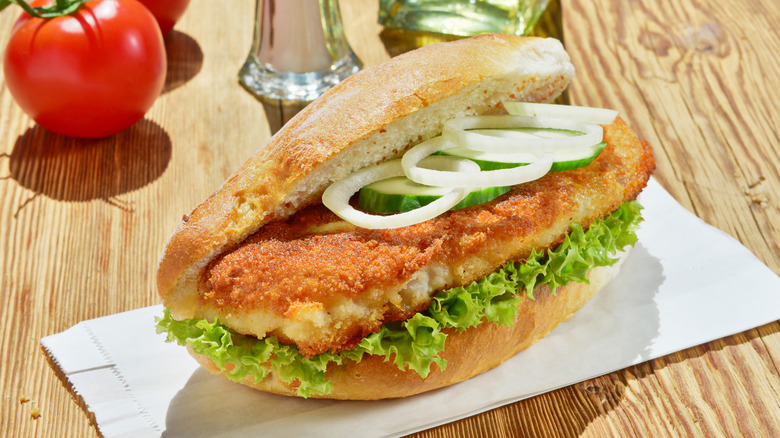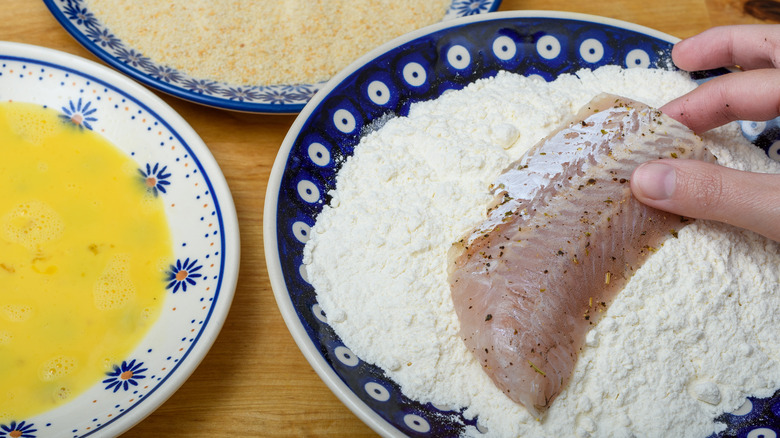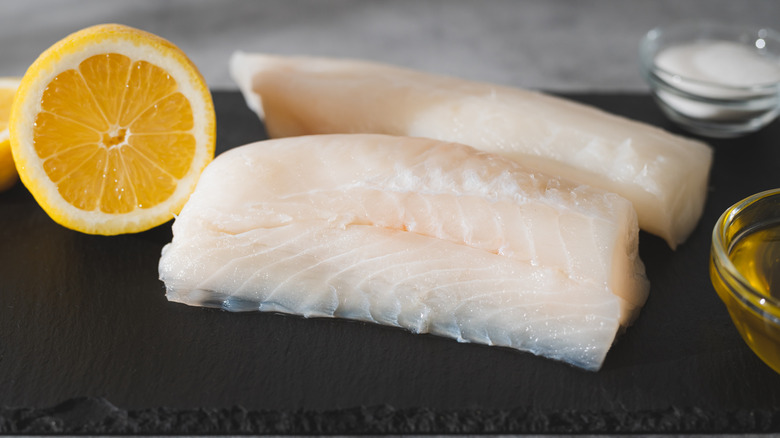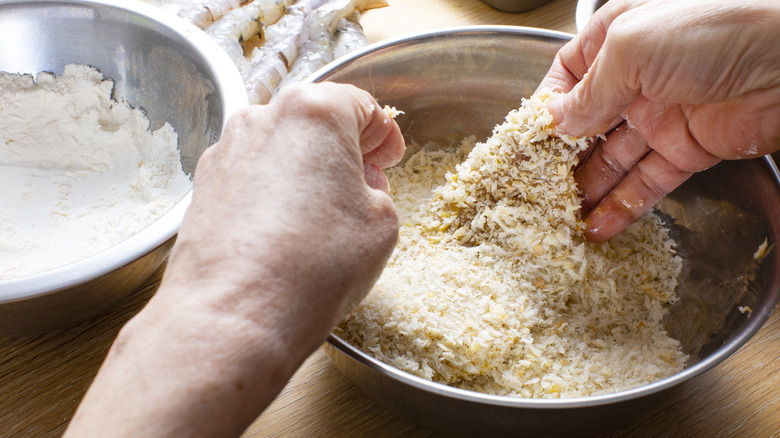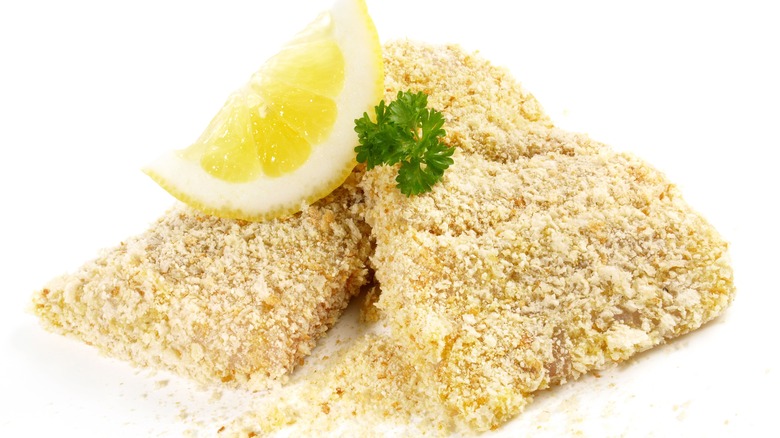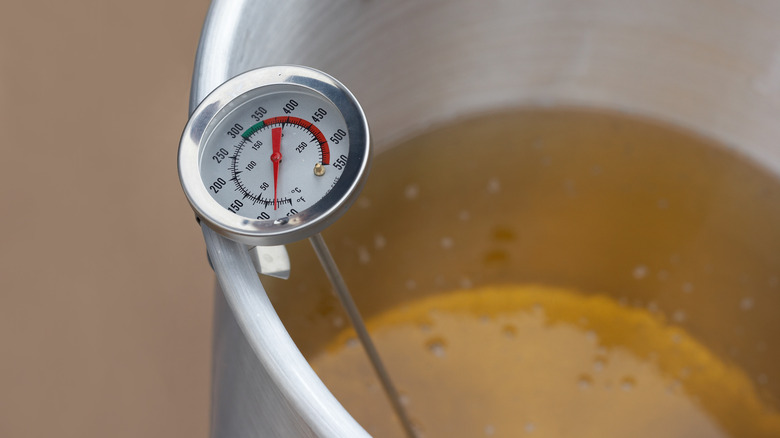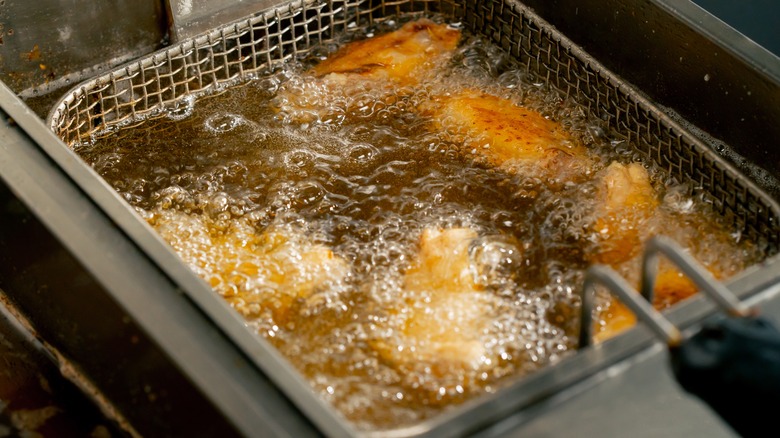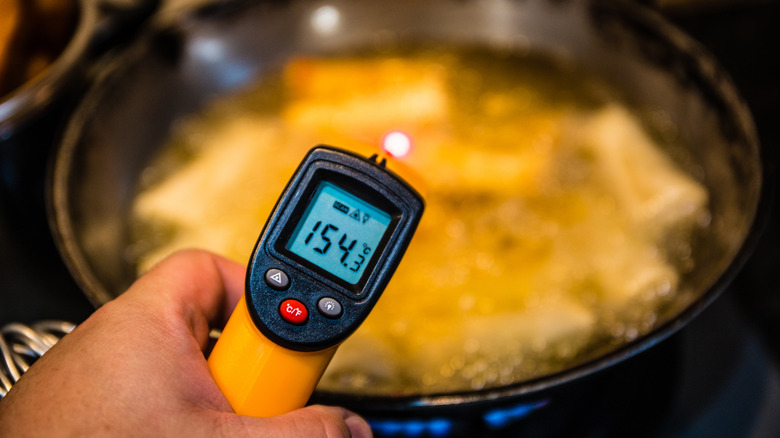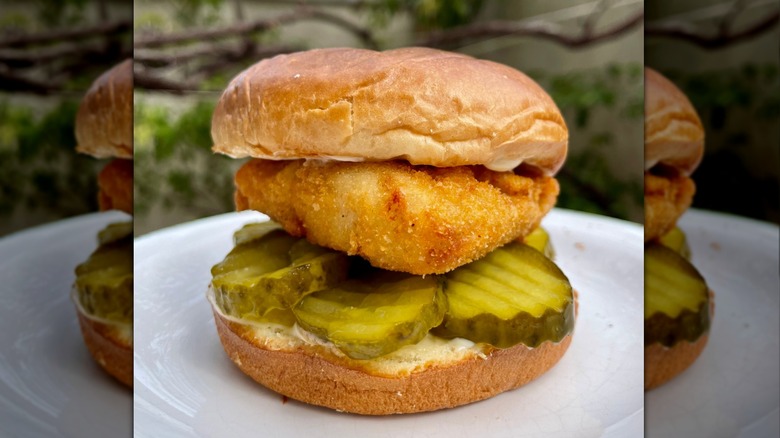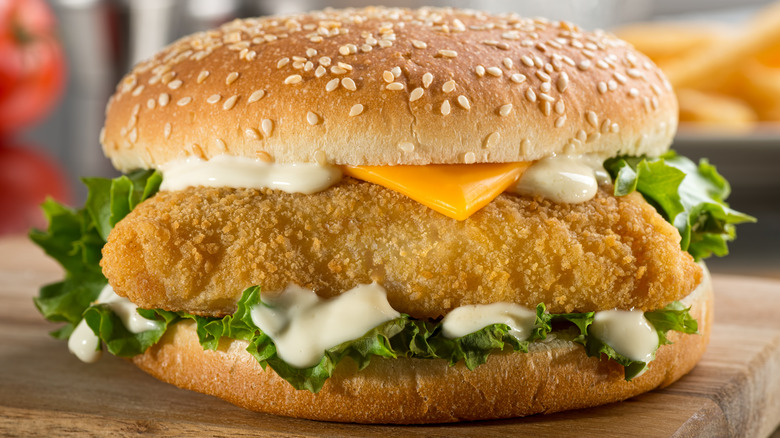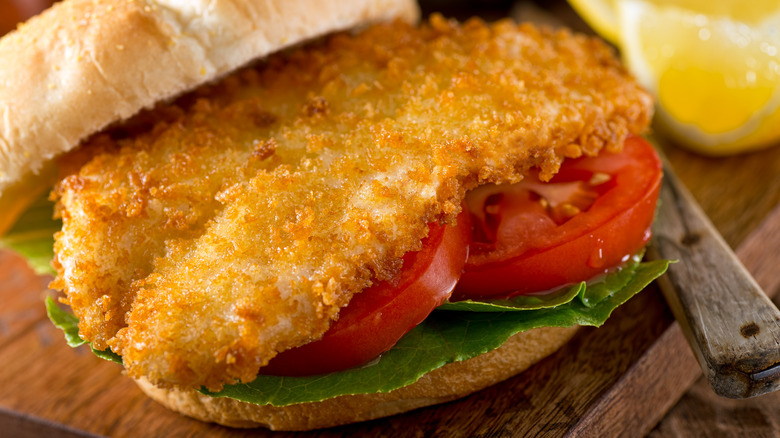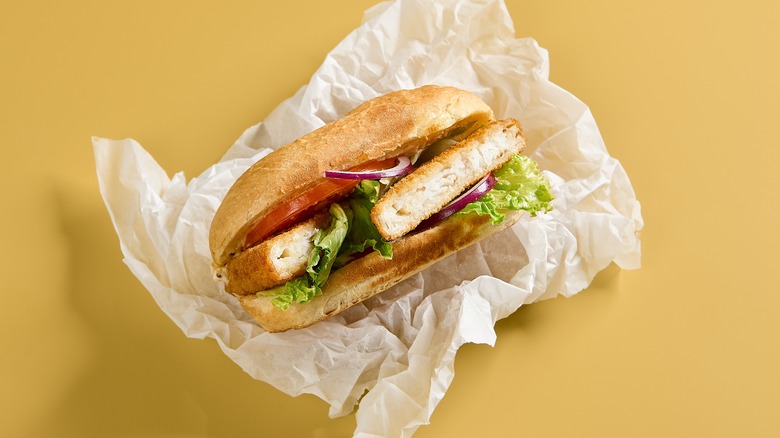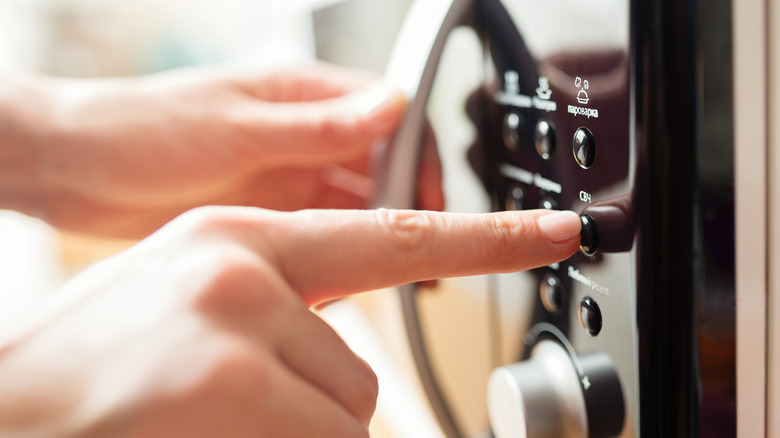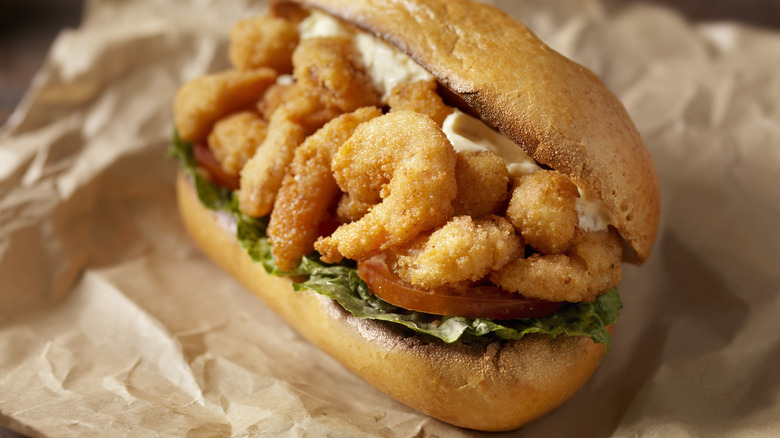The Absolute Best And Worst Ways To Bread A Fish Sandwich, Explained By A Pro
You crave that fried fish sandwich energy, but this time, you want it to slap, not flop. How do you get the crispiest, most tender and flavorful breaded fish filet you can possibly fry? We asked professional chef Collin Saum, principal culinary program manager for Whole Foods Market, to tell us everything he knows. Lucky for us, he's well-versed on his fish sandos.
If you're guessing it all comes down to the tartar sauce, wondering if everything rides on the breading recipe, or thinking that a cheese and seafood pairing could never be a thing, Saum steers us in the right direction when it comes to crafting the best fish sandwich, from the salty sea to your kitchen table. He also offers up a few pointers on grocery shopping for those clutch sandwich elements, including one of our favorite food groups: bread.
Grab your deep fryer; a frying pan will also do. From prepping, to cooking, and stacking your finest ingredients, these are the hacks to know — and the pitfalls to avoid — for making the best breaded fish sandwich.
Keep one hand dry and save the other hand for wet work
This is your official warning that, no matter what you do, it's probably gonna get a little messy. But even if you pull an Alton Brown and don surgical gloves to prep your food, it still streamlines the process to dedicate one hand to the wet stuff, and one hand to the dry parts.
"In the standard 3-step breading process, it is critical to firmly press the breading into the meat/fish on the last step," Collin Saum explains. Sharing an easy technique that allows you to prep all of your fish without stopping to wash your hands in between filets, he suggests, "Use the wet hand/dry hand method to avoid messy breading on the fish."
The typical breading set-up features a flour dredging station, an egg station, and a breadcrumb or panko station. Since you want the breading to evenly stick to the fish and not to your hands, leaving one hand out of the egg wash ensures that your filet receives a full coating of flour, egg, and breadcrumbs without sticky fingers getting in the way.
Choose a light fish for your sandwich
While we'd love to fry up our catch of the day right on the beach, when it comes to fish sandwiches at home, it's all about white fish. (You can also cook up some other sea creatures, too.)
"Always lean toward mild and flakey fish such as cod, flounder, catfish, or tilapia," notes chef Collin Saum. "Oysters, shrimp and scallops are also good options." These particular species are typically less "fishy" in flavor and offer a lower oil content, along with tender, white meat that happens to taste out of this world with a breadcrumb coating.
You could fry up your favorite sockeye salmon, but Saum warns against using those types of fattier fish that are best for serving without a breaded crust. He says, "Steer clear of monkfish, swordfish, salmon, and tuna because their texture and/or fattiness makes them a less-than-ideal choice. I'd also avoid fish with higher costs such as halibut, which is better left for roasting and sautéing."
Remember to press the breading onto the fish
Whether it's fried onion rings, or fish filets, no one likes when all the flavorful breading falls off their food. To guard against this scenario as much as is humanly possible, Collin Saum, Whole Foods Market principal culinary program manager, reminds us to gently, but intentionally, press the breading mix onto the fish.
"For a battered-style fried fish (like one you would get when you order fish and chips), it is difficult to have the batter not fall off when eating," he says. "But if you are making a more traditional breaded fish, when you bread the fish, press the breading in firmly without damaging the fish." Utilize some care — at least until fish-based smash burgers become a thing.
While even the most perfectly seasoned, crispy-crusted breading recipe is vulnerable to total destruction by the time you take your first bite, this step sets up your fish for the best possible scenario. After all, what was your dry hand doing this whole time other than hoping to really shine at the panko station?
Don't throw the fish straight into the fryer
Yes, you're ready to get this fish sandwich party on the road, but don't just chuck your delicately breaded masterpiece straight into the fryer. Another method for keeping the breading on your fish intact involves leaving your fish in the fridge to chill, while the egg wash and flour combo works its sticky magic.
After your filet has completed its trip through the breading station, Whole Food culinary manager Collin Saum notes, "Allow it to rest in the fridge for 20-30 minutes before frying. This can help the breading settle and bond to the fish." There's also another benefit to taking the time to let the fish rest. All that refrigerated air cools down the temperature of the filet, so there's less risk of overcooking it once it hits the deep fryer.
Some cooks suggest breading the fish up to a day in advance, as long as you keep it covered and refrigerated. It's a winning strategy, as long as you can stand dreaming about the perfect fish sandwich just a little bit longer.
Make sure your cooking oil maintains the right temperature
It might not seem like it, but keeping your frying oil heated to the proper temperature might be the most crucial step in fish sandwich making. "The temperature of the cooking oil may be more important than the breading steps. It is critical that you have a nice 350 to 375 Fahrenheit when frying," chef and culinary manager Collin Saum says.
Start with a neutral-flavored oil (like canola, or vegetable oil which have a high smoke point and can take the heat without deteriorating). You'll also want to keep a food thermometer on hand if your fryer doesn't already have one built in.
Temperature is everything when it's go time on the fryer. As Saum shares, "If too cold, the breading will soak up the oil and eventually overcook. Too hot and the breading may burn, leaving a bitter and maybe undercooked product. Keep an eye on temperature, it will drop when you add the fish to it and the sooner it comes back to temperature, the better it will be."
Avoid crowding your fryer or fry pan
Resist the temptation to throw all the fish into the fryer at once just to get dinner on the table. For the best results, and no accidental steaming, leave a little room around each of your fried items as they simmer in the oil.
"Use a large enough fryer so you don't crowd the fryer, which drops the oil's temperature and creates steam," Collin Saum explains. On the flip side, restaurants and other industrial kitchens can handle a heftier load. He says, "Commercial deep fryers are 'deep' meaning they hold a lot more oil than a large pot or dutch oven and can withstand a crowded fryer without the temperature dropping too much."
So what's the solution if you've got a lot to fry and not a lot of room to do it? Saum recommends, "Fry in batches using either a large pot, filled halfway with oil, or a shallow sauté pan."
Use a thermometer if you're cooking in a frying pan
Just because you're using a frying pan, and not a deep fryer, doesn't mean the oil temperature doesn't matter. Perfectly crispy pan-fried fish also depends on that 350 to 375 Fahrenheit window.
"If using a shallow pan, use a surface temperature reader to keep an eye on your temperature levels," shares Collin Saum, Whole Foods Market chef. "When you turn the fish, the temperature will likely drop which would trigger an increase in heat." A point-and-shoot style infrared food thermometer will give you immediate results so you can keep that fry pan piping hot.
But even after you nail the frying pan segment, there's still one more step to get the toastiest, crunchiest crust. As Saum tells it, "For crispier fish, fry at the proper temperature, and once removed from oil, allow to rest/drain on a wire rack above a sheet pan. This allows air flow and prevents steam buildup."
No need to get fancy with the baguettes
This is one dish where you don't want to go all in on the crusty, multi-seeded, artisanal bread. In a textural play that can only be described as pure heaven, the crispy crunch of fried, breaded fish is best complemented by a soft, springy bun.
"Stick to the rolls and buns category," Collin Saum confirms. "You can't go wrong with a toasted brioche bun or consider trying something along the lines of an onion roll, Portuguese roll, Kaiser roll, or even a potato or ciabatta style roll." We're looking at you, Hawaiian rolls, all standing in a cute little row in your package, like aspiring mini fish sliders.
As far as some of the fancier stuff in the bread aisle goes, crusty, stiffer breads can fight against the pillowy essence of a good fish sandwich. For the record, you can skip the white bread, too. Saum adds, "I would avoid the more rigid and dense baguettes as these can be challenging to eat in a sandwich form. I'd also steer clear of traditional grocery sliced style sandwich bread, as it often lacks thickness or 'body' needed to support a fried fish sandwich. Instead, look for an artisanal small-batch bread ¾-inch sliced and toasted if possible."
Avoid layering your sandwich with the fish on top
Just like you wouldn't build an upside-down pyramid, fried fish sandwich assembly starts with a good foundation. If you're one of those people wondering whether to start with coleslaw, or a bunch of mayo on the bottom bun, this is for you.
"Keep the fish closer to the bottom piece of bread," Collin Saum, Whole Foods Market, says. "Sometimes if you sandwich the fish between a tomato and lettuce there could be some slipping."
While we cringe at the thought of a messy, fall apart sandwich after doing all the work of frying the fish to perfection, we also acknowledge that sometimes you're hungry and you just want to eat. You've probably seen fish sandwiches layered in all kinds of ways by armchair chefs on the internet (Lettuce on top! On the bottom! On the side! On the floor!), but we think the best stack starts with a solid base. Whether that ends up being the fish, or a very stable bed of shredded lettuce, coleslaw, or mayo, one thing's for sure: It definitely doesn't start with a ripe, juicy tomato.
Don't throw fresh tomatoes into the mix
Love 'em or hate 'em, tomato slices bring fresh-from-the-garden flavor — as well as a massive amount of extra water. Rogue moisture is one thing you don't want to add to a crispy fish sandwich, but, thankfully, culinary expert Collin Saum's got us covered.
He explains that slightly altering your go-to toppings can dramatically elevate your sandwich game. "Anytime you can process the ingredients, it helps the sandwich hold together," he says. "For example, if using avocado, mash it slightly. Or, if using tomato, create a tomato jam or salsa. This will help the sandwich stay together."
You can make tomato jam yourself, and exactly no one would be mad about a quick chili crisp guacamole schmear in lieu of slippery, slide-y avocado slices. And are we seeing relish instead of pickle slices in our future? (We think we are.) Maybe these top-shelf additions make the humble fish'wich lean a little bougie, but if we get to chow down on condiments like these, we're okay with being fancy, too.
Okay, this one's a little cheesy!
Veering into the polarizing discussion about whether it's sacrilegious to combine seafood with cheese, we have the argument against it. (Well, kind of.) This is where personal taste meets decades of food-pairing culture and science.
"Cheese on a crab cake? Maybe, maybe not," Collin Saum, culinary program manager for Whole Foods Market, suggests, with a wink. "Buffalo scallops with blue cheese, I don't know but if you think it might work, try it!" The no cheese with seafood thing goes back to an old-world Italian home cook philosophy from zillions of years ago, which made it to the States and still has people abiding by the idea today. Whether it came about because of sensitive bellies, or a typically light-on-cheese Mediterranean diet, it checks out except for one thing: People all over the globe love eating seafood with cheese. Exhibit A: Lobster mac.
"What matters is if you like it, not if someone else thinks you should," Saum declares. We're printing that mantra on a tea towel for our next fish sandwich night. The bottom line: "There are no strict rules on this one. If it tastes good, I say do it," Saum adds. As a delicious illustration, he offers, "Shrimp parmesan is a good example — nothing wrong with cheese here."
Avoid reheating your leftovers in the microwave
Dear reader, you worked hard to craft the most incredible fish sandwich of modern times. Whatever you do, let's respect the delicate balance of the crunchy, flaky filet and let us not nuke our leftovers into oblivion. For this dish, crispy texture is paramount, and microwaves notoriously have one function when it comes to fried, breaded things: Sogtown, USA. (It's obviously the result of a secret code that's triggered if you press 3-0-start because it happens every time.)
"Fried fish is best eaten right away," confirms Collin Saum of Whole Foods Market. But, even so, he has ideas on recreating the deep-fried magic of the day before, just in case you need it. "If you do reheat it, I would use an oven or a small toaster oven rather than a microwave or stove top pan."
If your leftover sandwich was already assembled, we suggest deconstructing it for maximum toastage. And, y'know, maybe don't warm up the lettuce and mayo if you don't have to. It may not reach the glimmering status of its former glory days (probably less than 24 hours ago), but it's the best way to heat up your fish sando for round two.
Check out the competition with Collin Saum's favorite restaurant fish sandwiches
Ready to take your deep-fried culinary talents on the road? We asked Collin Saum — you know, the culinary program manager over at Whole Foods Market — for the best breaded fish sandwiches in the country, and these are his hottest takes.
First up, the northeast contingent's got fried clams you won't forget. He says, "When in New England, get a clam roll. It may live in the lobster roll's shadow, but it is better in my opinion. Plump, whole-belly clams, fried golden brown on a toasted brioche roll with lemony tartar sauce. Look to Massachusetts' North Shore." Along the southeast, he promises you can't go wrong with the "catfish po boy at Olde Tyme Grocery in Louisiana — a classic." Then, heading north to the midwest, a traditional fish filet puts Cincinnati on the map. Saum recommends the "fried fish sandwich at Bridgetown Finer Meats in Ohio — the original fish filet." Great, Collin, now we're totally hungry. (Thank you!)
In the mood for a different kind of fish'wich? You've gotta taste Ina Garten's ultimate tuna melt recipe which happens to be just as comforting as a fried fish sandwich. (And, yes, of course there's cheese on it.)

